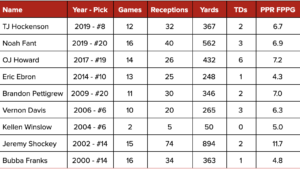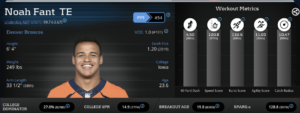
You Missed Out on Kelce and Waller… Now What?
In my last post, I discussed the benefits of drafting an early-round tight end, specifically when you should feel comfortable drafting the top-ranked TEs, Travis Kelce and Darren Waller. So the question now becomes, what should you do as a fantasy manager, if you aren’t able to secure one of the top two options? According to current average draft position (ADP) data from Underdog Fantasy, George Kittle and Kyle Pitts are often the next two tight ends going off the board in 2021 points-per-reception (PPR) fantasy redraft leagues. Is it imperative to select one of these two? Or does the lack of options available at the TE position cause fantasy managers to overpay for these secondary options?
In this article, we will analyze Kittle and Kyle Pitts to assess their 2021 season outlook and draft value. At the end of each analysis, we’ll evaluate their ADP to determine whether Kittle and/or Pitts are worth their current price, and when you could draft these TEs without “reaching,” or drafting these players too early and spending too much draft capital.
George Kittle

First up is George Kittle of the San Francisco 49ers. In recent years, Kittle has been atop of TE rankings, usually right next to Travis Kelce. However, Kittle is coming off an injury-riddled season last year, where in only eight games played, Kittle finished with 48 catches for 634 yards and found the endzone twice. For fantasy, this resulted in just over 125 PPR fantasy points, or 15.6 PPR fantasy points per game (FPPG). While he finished as the TE19 in terms of overall fantasy finish due to missing half the season, Kittle posted the third-highest FPPG last year, behind only Kelce and Waller.
In Kittle’s last full season (2019), he finished with 85 receptions / 1,053 yards / 5 TDs in 14 games played. This was the second-best TE fantasy point production that year (again, only behind Kelce), but tied Kelce for the top FPPG. According to current PPR ADP data, Kittle is being drafted in the early third round with the 26th overall pick.
Kittle has proven that he’s a yearly top-TE, but let’s take a look at his 2021 season outlook. Last year proved to be a breakout year for 49ers WR Brandon Aiyuk, so the 49ers now have three solid pass catching options in Brandon Aiyuk, Deebo Samuel and George Kittle. However, since Kittle only played in eight games, and Deebo only played in seven, what does the 49ers offense look like with all three pass catching weapons available? Last year, there were only four games where Aiyuk, Samuel and Kittle all played.
 *Note: Aiyuk also added a 38-yard rushing TD against Philadelphia in Week 4
*Note: Aiyuk also added a 38-yard rushing TD against Philadelphia in Week 4
Over the last three NFL seasons, Kittle has averaged 5.8 receptions per game, well below his 7.75 receptions per game last year with Aiyuk and Deebo healthy. Although this is a small sample size of only four games, it appears that Kittle will remain a focal point of the 49ers passing game, regardless of whether Aiyuk and Deebo are both on the field. To look for further evidence in support of this argument, let’s examine the 49ers pass offense with and without Kittle:
 Regular season games only (2019-2020)
Regular season games only (2019-2020)
We can now more clearly see how George Kittle’s presence affects Aiyuk and Deebo. When in the lineup, Kittle has drawn targets away from the 49ers’ other top pass catching options – not the other way around. Given these previous numbers, we shouldn’t be too worried about a healthy Brandon Aiyuk or Deebo Samuel taking target volume away from Kittle. Overall during the last three NFL seasons, Kittle has commanded targets within this 49ers offense. Without Kittle in the lineup, the 49ers targeted WRs on 57.5% of pass attempts. However, that WR target rate plummeted to only 48.1% when Kittle played.
Kittle’s fantasy production over the past three NFL seasons of about 16 FPPG (in PPR formats), combined with being the clear priority pass catching target on his team, could put him in the Kelce / Waller TE tier, if not just below the top options. As Matt Flowers, a colleague at Yards Per Fantasy, proved in his recent article “Spotting A Top Tight End for Fantasy Football,” 96% of Top-5 fantasy TEs were either first or second on their team in targets. Assuming he remains healthy for a majority of the upcoming season, there’s a great probability that George Kittle leads the 49ers in targets this season.
Drafting Kittle at his current ADP – 26th overall according to Underdog Fantasy – seems like a fair price for the last option of a locked-in Top-5 TE, assuming Waller and Kelce have already been selected. Depending on how your specific league draft goes, and your preferred early round roster selection, Kittle could be a welcomed addition to your team in the early third round. For example, if you had the first or second pick in your draft, you could have your first three picks as a top-tier RB (McCaffery or Cook), a top-tier WR (Justin Jefferson, AJ Brown, DK Metcalf), and then Kittle as one of the best TE options.
If you prefer waiting on WRs until the middle rounds and want to go with two highly ranked RBs early, you’d still be set with CMC/Cook in the first round, someone like Gibson or Clyde Edwards-Helaire caliber in the second, then selecting Kittle in the third. This would still leave your 4th and 5th rounds open for your first WR selections, where you might be able to pick up receivers like Cooper Kupp, Diontae Johnson, and Kenny Golladay.
Kyle Pitts

Next, let’s take a look at Kyle Pitts of the Atlanta Falcons. Pitts is heading into his rookie year in the NFL after being selected by the Atlanta Falcons with the 4th overall pick of this year’s NFL Draft. Last year, in only eight games played (limited season due to COVID) at the University of Florida, Pitts hauled in 43 catches for 770 yards and 12 touchdowns. In the previous year, Pitts was less efficient on a per game basis with 54 catches, 649 yards, and 5 touchdowns in 13 games. According to current PPR ADP data, Pitts is coming off the board towards the end of the fourth round with the 46th overall pick.
There are tons of reasons that expectations for Kyle Pitts are extremely high right now: his athletic profile (the dude is 6’6” and weighs 245 pounds!), his college career (see stats above), and the large opportunity he’s walking into with the Atlanta Falcons. Following the Julio Jones trade this offseason, the only proven receiving threat on the Falcons is Calvin Ridley. Assuming that Ridley will seemingly be drawing most attention from opposing defenses in terms of best defenders and double teams, people expect Pitts to have a ton of targets in a pass heavy offense, for a team that will be playing from behind and looking to pass often.
Pitts is also joined by Arthur Smith as a new addition to the Atlanta Falcons this year, as Smith was hired as the Falcons’ head coach during the offseason. The new head coach only adds to the optimistic outlook for Pitts’ rookie season due to Smith’s history of featuring TEs in the offense.

Clearly Smith has a track record of utilizing the TE in the passing offense. His various offenses over the last six years have averaged over 130 TE targets, which equated to a 27.5% target share – meaning 27.5% of all passes were intended for a TE. This even includes the outlier year of 2018, when the TItan’s top TE, Delanie Walker, was injured in Week 1 and then unable to play for the remainder of the year.
While the team situation and offensive opportunity seem to be optimal for Pitts to have a fantastic year, TEs have almost never had fantastic rookie seasons, especially from a fantasy football standpoint. The best rookie TE performance (by far) was Mike Ditka back in 1961. In 14 games, Ditka caught 56 passes and turned those receptions into 1,076 yards and 12 touchdowns. This season-long statline would equate to 16.8 PPR fantasy points per game, easily putting Ditka’s rookie year on par with Waller and Kittle expectations. But is it realistic to expect this from Pitts too? Kyle Pitts was the earliest drafted TE in NFL history, but let’s take a look at rookie season statistics for other recently high-drafted TEs:
 Rookie year statistics for all TE drafted in the first 20 picks of the NFL draft, since 2000
Rookie year statistics for all TE drafted in the first 20 picks of the NFL draft, since 2000
If Pitts is no different than other recently high-drafted rookie TEs, you certainly wouldn’t be happy with the fantasy points per game outcomes listed above. Six of the nine TE listed above averaged under 7.0 PPR FPPG, and all except one averaged under 7.3 PPR FPPG… that type of production is not what you’re looking for from a fantasy football fourth round TE selection. One common counter argument to this might be that Pitts is more athletic, and therefore more likely to produce or play more like a WR than a TE. In order to analyze this counterargument, let’s dive into some of Pitts’ athletic measurements and college performance.
PlayerProfiler is a great data source to measure and evaluate NFL players’ athleticism and college performance (given different levels of competition across college football). Here are some of the data points available through PlayerProfiler:
- 40-yard Dash – Note that Pitts’ time was adjusted +0.05s due to it being hand-timed.
- Speed Score – Assigns a premium to 40-times run by tall, heavy TEs. Any number over 115 is considered extraordinary for TEs.
- Burst Score – Equally weights and sums Vertical Jump and Broad Jump distances to measure explosiveness from a standstill. Any number over 130 is considered extraordinary for TEs.
- Agility Score – Sums 20-yard Short Shuttle time and Three Cone Drill time to measure short area quickness and balance. Any number under 11.1 is considered extraordinary for TEs.
- Catch Radius – Incorporates a player’s ability to cover ground laterally as well as to go airborne to catch a football in a three-dimensional space. Any number over 10.25 is considered extraordinary for TEs.
- College Dominator – The percentage of a TEs total team receiving yards and receiving touchdowns in college. Any value over 30% is considered extraordinary for a TE.
- SPARQ-x – An approximation of Nike’s SPARQ-x (Speed, Power, Agility, Reaction, and Quickness) rating.
 Source: PlayerProfiler
Source: PlayerProfiler
Clearly, Pitts should be considered almost in a league of his own in terms of his athleticism and workout metrics, right? He’s in the 99th percentile for his 40-yard dash time and the 98th percentile Speed Score. On top of this, Pitts has a 10.21 catch radius (85th percentile) and is also placed in the 87th percentile based on his SPARQ-x. PlayerProfiler aggregates physical attributes, workout metrics, and college / pro productivity and efficiency to determine each player’s most similar NFL peer. Are you curious about what current NFL player is most similar to Kyle Pitts…?
 Source: PlayerProfiler
Source: PlayerProfiler
That’s right – Noah Fant. The same Noah Fant, who averaged 6.9 fantasy PPR points per game during his rookie season, is the most similar NFL player to Kyle Pitts. Still willing to spend your fourth round draft pick on a Noah Fant-esque TE?
I get it, the opportunity for Pitts is likely to be more conducive to fantasy production than Fant’s rookie opportunity, but based on Pitts’ current PPR ADP in fantasy redraft leagues, he’s being drafted at his ceiling. In the best case scenario, Pitts puts up an historic rookie TE season and averages around 12-15 PPR points per game.
But you don’t want to be drafting players at their ceiling! Despite the ideal team situation and opportunity, I wouldn’t be drafting Kyle Pitts anywhere close to his current draft price, spending a fourth round pick on him. If Pitts happens to still be available in your draft after TJ Hockenson and Mark Andrews (who are both being selected at the end of the fifth round) have been selected, then maybe I’d spend a sixth round pick on Pitts. In an ideal, but very unlikely, scenario that Pitts is still available in the seventh round of your redraft, then I’d be willing to take the gamble on him having an all-time great rookie season, given the amount of opportunity in this pass-heavy offense with Smith targeting the TE often.
Be on the lookout for the next article in this series, as we’ll soon take a look at Mark Andrews and TJ Hockenson!






